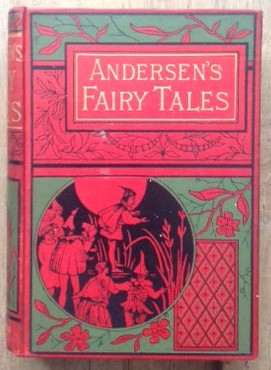Inspiring Young Readers
 posted on 12 Jul 2017
posted on 12 Jul 2017
Fairy Tales and Stories by Hans Christian Andersen translated by Dr H.W. Dulcken
There must literally be thousands of different editions of the stories of Hans Christian Andersen’s in various translations, retellings and illustrated formats that have been produced since he first began publishing his collections in the 1830s. I personally like to keep my eyes open for the later Victorian editions that spare no expense in terms of their extravagance and sumptuous design and production. Producing a show-stopping artefact was a Victorian obsession – enough was never enough, almost anything could be further embellished.
This 1885 copy published by George Routledge is a case in point. These were the days before the decorative dust jackets we are used to today and for the Victorian book-buyer – adult or child – a plain, disposable wrapper would cover a beautifully tooled and colourful set of book-boards. In this case red, gold and black designs that have a hint of both the Aesthetic sensibility and the emerging art nouveau. The block edges of the book are vibrant with gold leaf.
Routledge had founded his publishing company some forty years or so before the date of this book and would clearly have had an established reputation – strong enough to bring in experienced and well-seasoned people to help with translation, design and illustration. Dr. H.W. (Henry William) Dulcken (1932 – 1894) was by this point an experienced translator of Andersen and had done work for the famous Dalziel Brothers who illustrated some of the finest books of this period.
The artist chosen for the illustrations was also someone with a serious reputation - Alfred Walter Beyes. Beyes (1831 – 1909) was a northern, working class, largely self-taught artist but who had aspirations to become a fine artist of a more classical kind. However, he did work for a number of years for the Dalziel Brothers – a clear link to Dulcken with whom he almost certainly collaborated.
It seems almost certain that Beyes was not the only artist employed on this book – the black and white engravings are clearly by a different hand to the colour plates. I have seen it suggested that the other artist was Jessie M. King, one of the so-called ‘Glasgow Girls’ who would go on to be a top children’s book illustrator. However, I can’t see that this can be the case – King would only have been 13 or 14 when this book was published and that seems unlikely.
One of the other virtues of older translations of the Andersen tales is that they tend not to pull their punches – the cruelty and suffering implicit in many of the stories is there to see and not edited out in deference to some supposed squeamishness or a belief that children shouldn’t be exposed to hard-hitting morality tales.
And I guess this raises the legitimate question of whether a book like this was produced for children or for adults. It’s certainly a thick volume and the text is dense – not something we associate with childhood reading these days. However, looking back at children’s annuals and other story books of the time, very little concession is given to the reluctant child reader – there was an expectation that the Victorian child would have the capacity to deal with acres of text and to concentrate on the task.
However, it also has to be acknowledged that this was probably produced for reasonably well-off middle class children who might also expect to be read to by a parent, nanny or tutor. This wouldn’t have been a cheap book to buy when it came out and I expect it would have been bought to be part of a young person’s library and something they might hang on to as they grew up. It was dedicated as a gift – in a rather stiff and formal way – in 1893 and so this was probably purchased as new then.
Copies of the book in various states of repair can be found on internet trading sites but you should expect to pay between £30 - £50 for a good, solid one. That’s pretty expensive so maybe it’s one to add to the list when you’re out browsing the second hand shops.
Terry Potter
July2017





